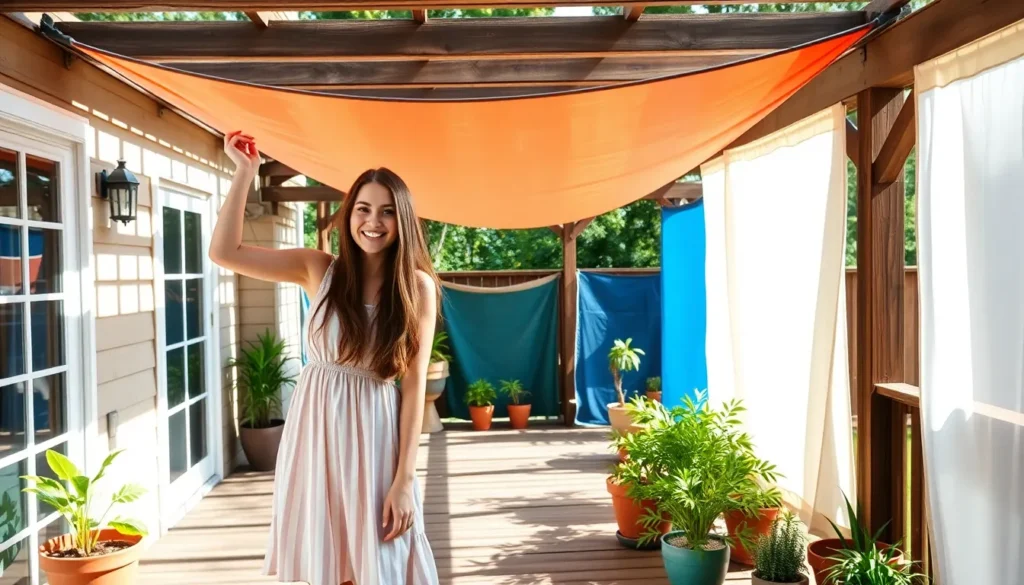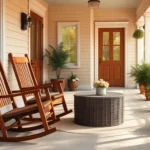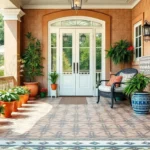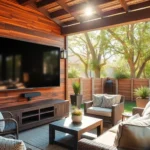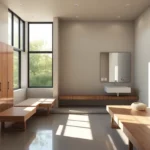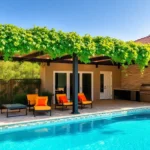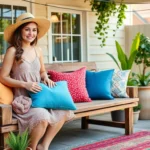Creating the perfect outdoor oasis doesn’t require very costly. We’ve all been there – standing on our scorching patio wondering how we can enjoy our outdoor space without feeling like we’re melting under the blazing sun. The good news? You don’t need expensive pergolas or professional installations to transform your patio into a cool comfortable retreat.
Budget-friendly shade answers can be just as effective as their pricier counterparts. From clever DIY projects using everyday materials to strategic plant placement that creates natural cooling zones we’ll show you how to beat the heat without emptying your wallet.
Whether you’re working with a tiny balcony or a sprawling deck these affordable shade ideas will help you reclaim your outdoor space. We’re about to share creative answers that cost less than your monthly coffee budget but deliver maximum comfort all summer long.
DIY Shade Sails for Maximum Coverage at Minimal Cost
Shade sails offer one of the most cost-effective ways to transform your patio into a comfortable retreat. We’ve found that these triangular or square fabric panels can reduce temperatures by up to 15 degrees while costing 70% less than permanent structures.
Choosing the Right Fabric and Materials
Canvas drop cloths provide the most budget-friendly option for DIY shade sails, costing between $15-30 for a 12×15 foot piece. We recommend selecting heavy-duty canvas with at least 10-ounce weight to ensure durability against wind and weather.
Outdoor fabric remnants from upholstery stores offer another affordable alternative, typically priced at $8-12 per yard. Look for solution-dyed acrylic fabrics that resist fading and mildew while maintaining their color through multiple seasons.
Grommets and hardware represent the most crucial investment for long-term success. We suggest purchasing stainless steel grommets ($12-15 per pack) and marine-grade rope ($20-25 for 100 feet) to prevent rust and deterioration.
| Material | Cost Range | Coverage Area | Durability |
|---|---|---|---|
| Canvas Drop Cloth | $15-30 | 12×15 feet | 2-3 years |
| Outdoor Fabric | $24-36 | 8×12 feet | 4-5 years |
| Hardware Kit | $20-25 | Multiple uses | 5+ years |
Installation Tips for Beginners
Measuring your space requires careful attention to existing anchor points like fence posts, trees, or pergola beams. We always add 2-3 feet to each measurement to account for the angled installation that creates proper tension.
Creating attachment points becomes simple when you identify sturdy structures that can handle 50-100 pounds of tension per corner. Eye bolts screwed into deck posts or tree straps around mature trees provide reliable anchor points without permanent modifications.
Tensioning the sail properly prevents sagging and extends fabric life significantly. We stretch each corner to create a 10-15 degree angle, ensuring water runs off effectively while maintaining structural integrity during windy conditions.
Testing the installation involves checking all connection points after 24-48 hours of initial setup, as fabric naturally stretches and settles into its final position.
Repurposed Tarps and Drop Cloths as Instant Shade Solutions
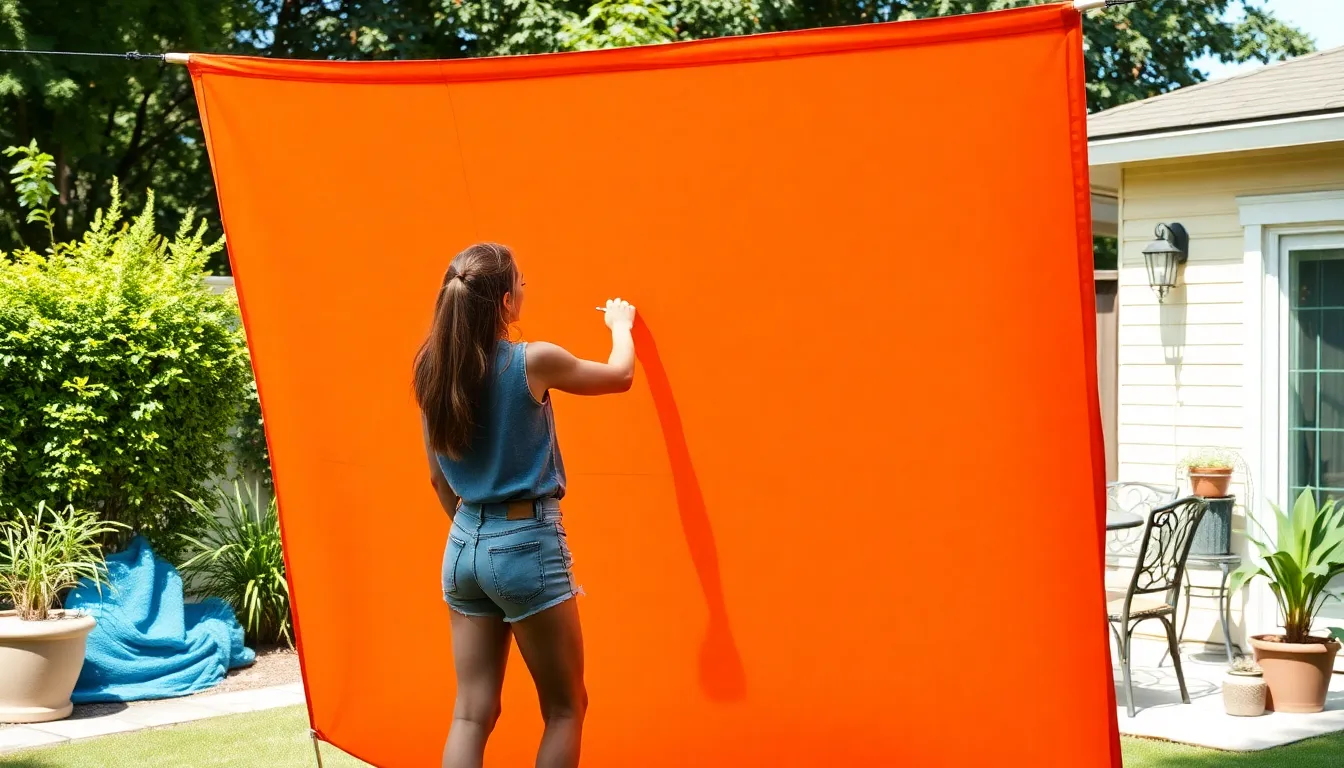
Building on our DIY shade sail discussion, we’ve discovered another budget-friendly approach that delivers immediate results. Canvas drop cloths and heavy-duty tarps offer versatile shade answers that cost significantly less than permanent structures while providing effective sun protection.
Securing Tarps Safely and Effectively
Anchoring your tarp shade requires sturdy connection points to ensure long-term stability. We recommend using existing structures like fence posts, trees, or your home’s exterior walls as primary anchor points. Tension hooks and coated cables provide the strongest hold, especially when paired with marine-grade bungee cords that won’t deteriorate in outdoor conditions.
Reinforcing corners prevents costly tears that can ruin your shade solution. We fold each corner twice before securing grommets, creating extra fabric layers that distribute stress more evenly. Adding fabric patches to high-stress areas extends your tarp’s lifespan significantly.
Proper angling ensures water runoff and prevents dangerous pooling during rainstorms. We always create a slight slope by positioning one side higher than the other, allowing rainwater to flow away naturally. Mounting your tarp on a wooden or metal frame increases wind resistance and provides more consistent coverage than simple tie-down methods.
Creative Ways to Make Tarps Look Stylish
Transforming plain tarps into attractive shade features starts with color customization. We use outdoor fabric paint or waterproof dyes to create patterns that complement our existing patio décor. Canvas drop cloths accept paint better than plastic tarps, giving us more design flexibility.
Decorative edging elevates the basic tarp appearance instantly. We attach fabric trim, colorful tassels, or pom-poms around the perimeter to soften harsh industrial edges. These details make tarps look intentional rather than temporary.
Layering creates depth and visual interest while improving shade quality. We position lighter-colored drop cloths over darker tarps to diffuse harsh sunlight and create pleasant ambient lighting underneath. Combining tarps with string lights or hanging plants transforms utilitarian shade into an inviting outdoor room that guests actually want to spend time in.
Strategic Umbrella Placement for Targeted Shade Coverage
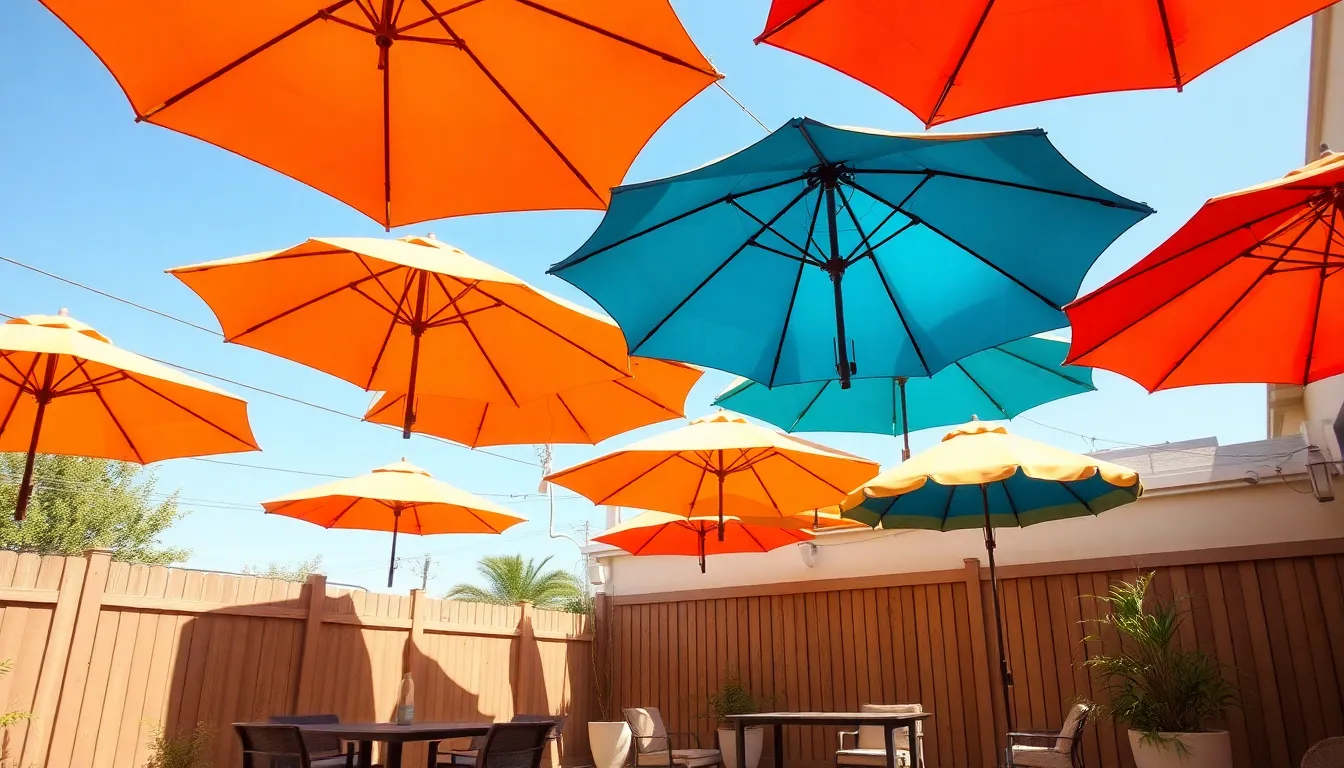
After exploring DIY shade sails and tarp answers, we’ll now focus on how smart umbrella placement can deliver targeted cooling without covering your entire patio. This approach lets you create comfortable zones exactly where you need them most.
Thrift Store and Clearance Umbrella Finds
We’ve discovered that thrift stores and clearance sales offer incredible umbrella deals that cost a fraction of retail prices. Second-hand umbrellas typically sell for 60-80% less than new ones, making them perfect for budget-conscious patio projects. You can often find quality brand-name umbrellas at garage sales, estate sales, and seasonal clearance events.
Refurbishing older umbrellas transforms them into stylish shade answers with minimal investment. We recommend using outdoor fabric paint to refresh faded canopies, replacing worn drawstrings with marine-grade cord, and reinforcing weak ribs with metal brackets from hardware stores. This sustainable approach reduces waste while creating unique patio accessories that reflect your personal style.
Shopping end-of-season clearances yields the best umbrella bargains, with retailers often marking down inventory by 70% or more. We suggest checking major home improvement stores in late August and September when summer merchandise gets heavily discounted. Building relationships with thrift store staff can also alert you to incoming donations of outdoor furniture and accessories.
Grouping Multiple Small Umbrellas for Large Areas
We position several smaller umbrellas strategically across larger patios to create comprehensive shade coverage at a lower cost than single oversized models. This method typically saves 40-60% compared to purchasing one large commercial umbrella or permanent structure. You can adjust individual umbrellas throughout the day to follow the sun’s path and maintain optimal comfort.
Arranging 3-4 smaller umbrellas in overlapping patterns provides flexible shade zones that accommodate different activities. We space them 4-6 feet apart to ensure adequate coverage while allowing air circulation underneath. This configuration works especially well for entertaining, letting you shade dining areas, conversation spaces, and cooking zones independently.
Small umbrella groupings offer repair advantages since damaged individual units won’t compromise your entire shade system. We recommend choosing umbrellas with similar base styles for visual cohesion while mixing canopy colors to create interesting patterns. This approach also allows you to expand your shade coverage gradually as your budget permits, starting with 1-2 umbrellas and adding more over time.
Build Your Own Pergola Using Reclaimed Wood
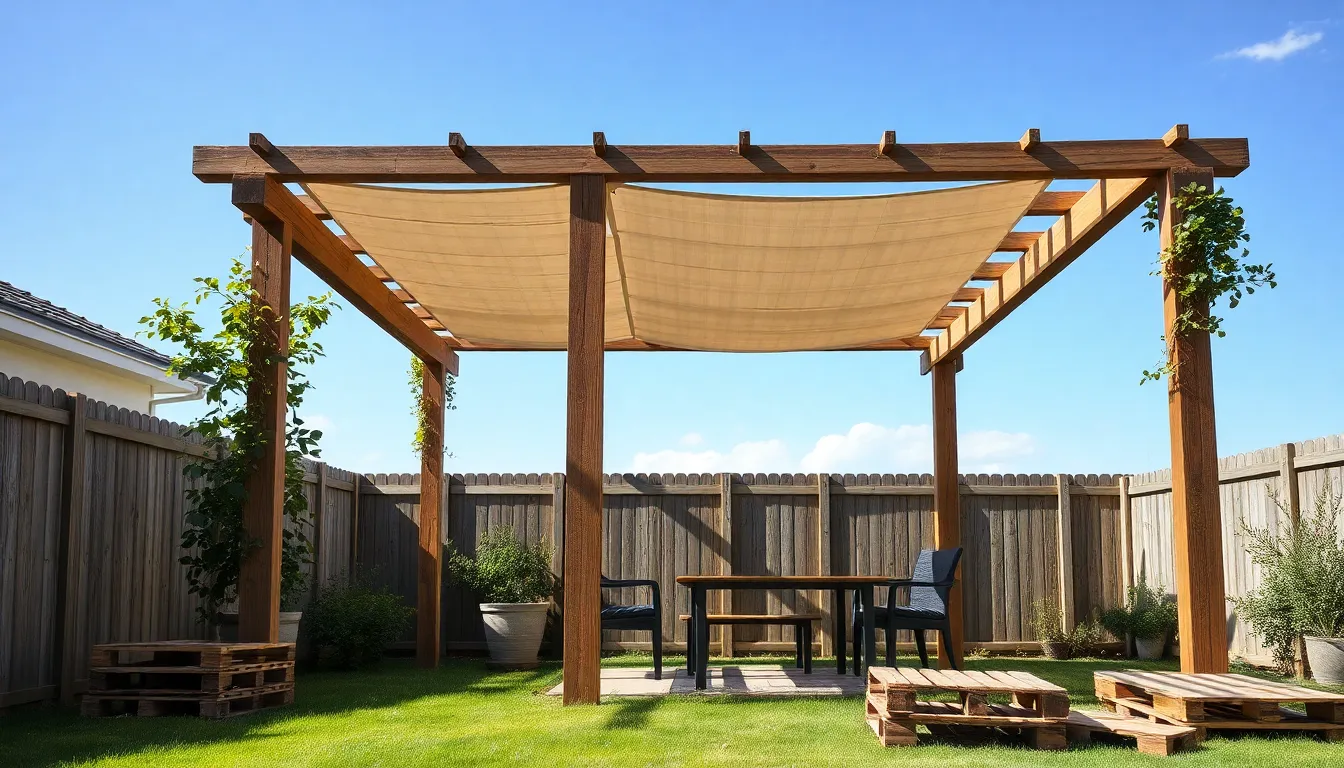
We can create a beautiful pergola structure that provides substantial shade coverage while staying within our budget constraints. Reclaimed wood offers an eco-friendly solution that costs 50-70% less than purchasing new lumber materials.
Sourcing Free or Low-Cost Lumber
We should start our lumber search at local construction sites and demolition projects where contractors often discard perfectly usable wood pieces. Construction crews frequently offer scrap wood and pallets for free or very cheap prices to avoid disposal fees.
Pallet wood represents one of our most accessible options since businesses regularly discard these sturdy wooden structures. We can find pallets at grocery stores, hardware stores, and shipping facilities where managers typically appreciate someone removing them from their property.
Facebook Marketplace and Craigslist provide excellent platforms for locating reclaimed wood sales in our local area. Community freecycle groups often feature building material giveaways where homeowners share leftover supplies from completed projects.
We need to inspect all reclaimed wood carefully for quality and safety issues before incorporating it into our pergola design. Treating the wood with weatherproofing answers prevents future decay and extends the structure’s lifespan significantly.
Simple Pergola Designs for Beginners
We recommend starting with a basic rectangular frame measuring 10×10 or 12×12 feet for manageable construction scope. This modest size keeps material costs low while providing adequate shade coverage for most patio areas.
Four vertical posts anchored securely into the ground form the foundation of our pergola structure. We’ll connect these posts with horizontal beams across the top using galvanized steel brackets for maximum stability.
Straight cuts eliminate the need for complex joinery techniques that require advanced carpentry skills. We can achieve professional looking results using basic tools like a drill, saw, and level throughout the construction process.
Cedar or redwood materials offer natural decay resistance when our budget allows for slightly higher material costs. These woods require minimal treatment while providing decades of reliable service in outdoor conditions.
Shade coverage improves dramatically when we add fabric panels, shade sails, or climbing plants across the pergola’s top structure. We can install tension hooks and cables to support removable shade cloths that adjust seasonally.
Anchoring posts properly ensures our pergola withstands wind and weather conditions throughout the year. We should dig post holes at least 2 feet deep and use concrete footings for permanent installation stability.
Plant-Based Shade Solutions with Fast-Growing Vines
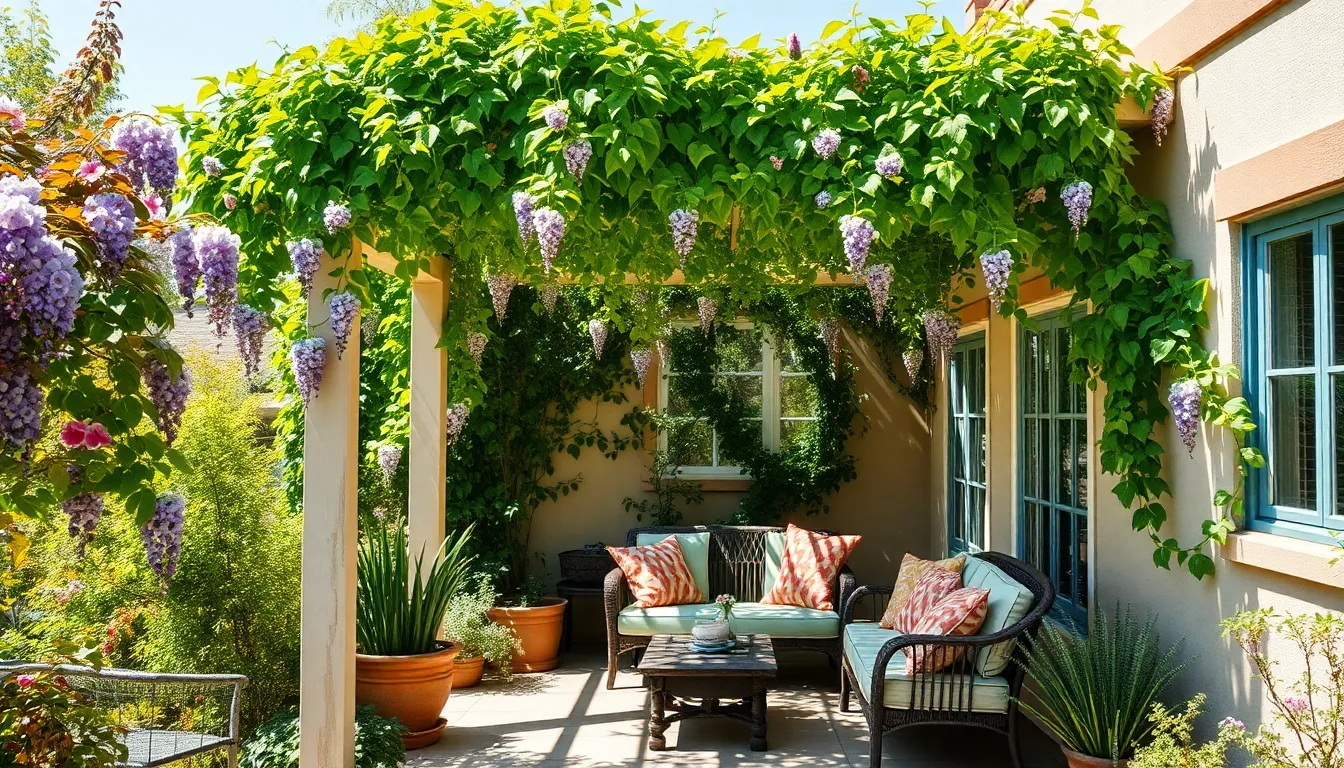
Nature provides some of the most effective and affordable shade answers for your patio through strategic use of climbing plants. We’ve found that combining fast-growing vines with simple support structures creates a cooling canopy that blocks sunlight while adding natural beauty to outdoor spaces.
Best Climbing Plants for Quick Coverage
Wisteria tops our list as a vigorous climber that delivers dense foliage coverage alongside stunning cascading flowers. This hardy vine transforms basic structures into lush shade canopies within a single growing season.
Morning Glory offers rapid annual growth with trumpet-shaped flowers that bloom in vibrant colors throughout summer. We recommend this low-maintenance option for renters or those wanting seasonal coverage without long-term commitment.
Clematis provides quick establishment with attractive blooms available in purple, white, pink, and red varieties. This versatile climber works well on trellises, fences, or pergola posts to create targeted shade zones.
Sweet Pea delivers fragrant blossoms while quickly covering vertical surfaces with lush green foliage. Annual varieties reach full coverage in just 8-12 weeks, making them perfect for immediate shade needs.
Trumpet Vine creates exceptionally dense leaf coverage with large, bright orange or red flowers that attract hummingbirds. This perennial vine establishes quickly and provides reliable shade year after year once established.
Creating Temporary Trellises on a Dime
Wooden pallets serve as instant vertical supports when positioned upright against walls or fences. We source these free from local businesses or find them for under $10 at hardware stores, then secure them with basic brackets.
Bamboo poles create lightweight frameworks when lashed together with outdoor rope or zip ties. Garden centers typically sell 8-foot bamboo stakes for $3-5 each, making them ideal for budget-conscious trellis construction.
PVC pipes offer versatility for creating custom trellis shapes using simple T-joints and elbow connectors. A basic 6×8 foot framework costs approximately $25-30 in materials and assembles without special tools.
String grids stretched between posts provide climbing guidance for lightweight vines like sweet peas and morning glories. Marine-grade twine costs under $10 and creates extensive support networks when properly tensioned between anchor points.
Outdoor Curtains Made from Affordable Fabrics
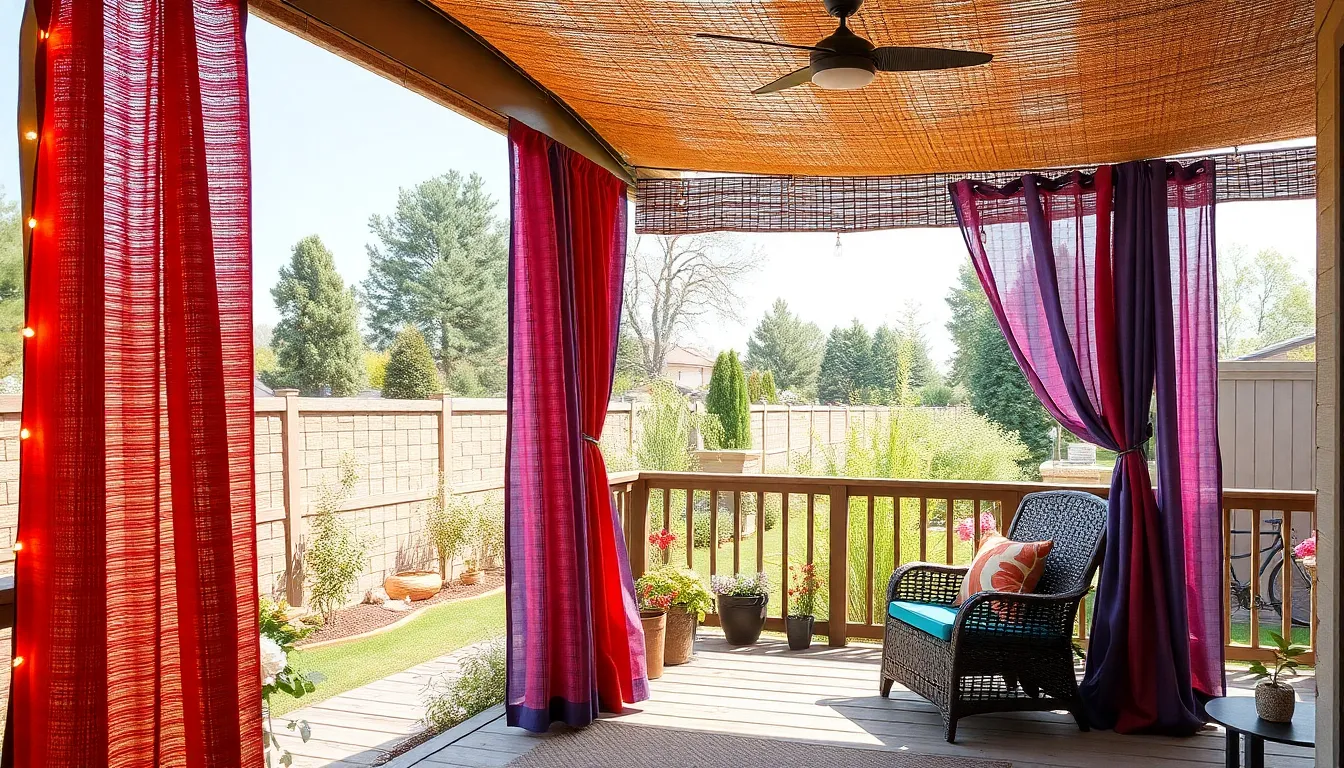
Outdoor curtains offer another versatile approach to patio shade that combines style with budget consciousness. We’ve discovered that this solution works particularly well for patios needing adjustable coverage throughout the day.
Polyester and acrylic blends deliver excellent value as they resist fading and mildew while costing significantly less than premium outdoor fabrics. Marine grade fabrics provide the ultimate durability for DIY projects, ensuring your curtains withstand both intense sunlight and sudden rainstorms.
Bamboo shades bring natural beauty to outdoor spaces while maintaining affordability across various styles including roll up and Roman designs. These eco friendly options complement any patio aesthetic while providing reliable sun protection.
DIY fabric curtains can be customized to match your existing outdoor décor using weather resistant materials that protect against UV damage. Canvas drop cloths and outdoor fabric remnants work exceptionally well for creating personalized shade answers at fraction of retail costs.
Weatherproofing Techniques for Longevity
UV resistant treatments extend fabric lifespan by preventing color fading and material breakdown from constant sun exposure. Fabrics treated for mildew prevention ensure your curtains remain fresh and functional even during humid summer months.
Water repellent sprays applied to untreated fabrics create an additional barrier against moisture damage and staining. These protective coatings should be reapplied annually to maintain maximum effectiveness.
Protective sealants work wonders on wooden frames supporting bamboo shades, preventing moisture related warping and rot. Regular maintenance with appropriate wood treatments keeps support structures stable for years.
Polycarbonate panel installations over curtain frames offer permanent weatherproof protection while allowing natural light to filter through. This combination provides UV protection without requiring frequent fabric maintenance or replacement.
Hanging Systems That Won’t Expensive
Tension rods provide the simplest installation method for lightweight outdoor curtains without requiring permanent mounting hardware. These adjustable systems work perfectly between posts or under covered areas.
Curtain wire with clips creates flexible hanging answers that accommodate various fabric weights and styles affordably. This system allows easy removal for cleaning or seasonal storage.
Grommet curtains hung from PVC piping offer professional appearance while keeping costs minimal through DIY assembly. Aluminum piping provides upgraded durability for slightly higher investment.
DIY lightweight frames constructed from PVC or aluminum tubing support larger curtain installations while allowing complete disassembly when needed. These portable systems can be relocated as shade requirements change throughout seasons.
Shade sails attached with inexpensive hardware create modern outdoor looks without costly professional installation. Marine grade fabric sails can be connected to existing structures or simple pole systems for under $250 depending on size requirements.
Patio umbrellas and pop up canopies eliminate complex hanging systems entirely while providing immediate portable shade answers. These options require no installation and can be easily stored during harsh weather conditions.
Creative Use of Bed Sheets and Tablecloths as Shade
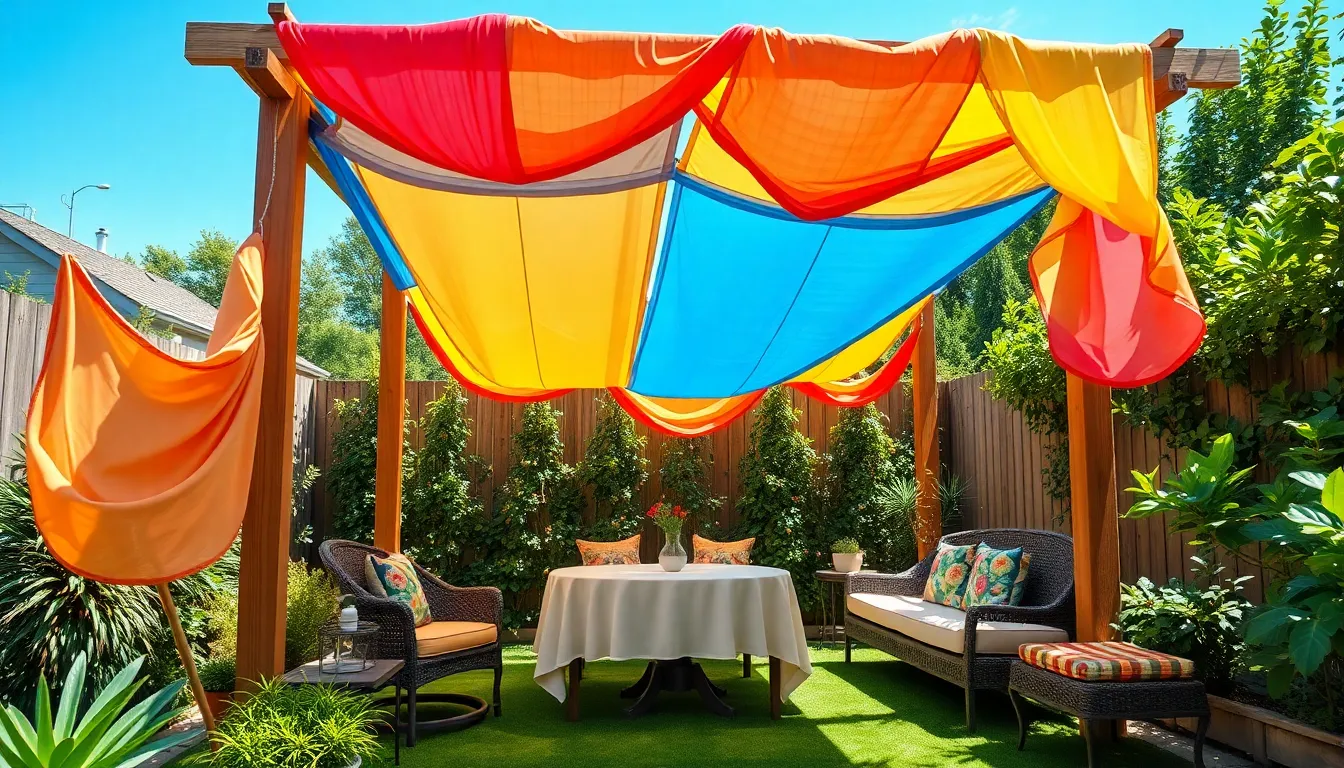
We’ve discovered that repurposing household textiles creates surprisingly effective patio shade at a fraction of traditional costs. Large canvas sheets or outdoor tablecloths stretched over wooden frames or pergola structures deliver modern, budget-friendly coverage that rivals expensive commercial options.
Securing Lightweight Fabrics in Windy Conditions
Installing grommets transforms ordinary bed sheets into weather-resistant shade answers that won’t tear or flap in strong winds. We recommend adding metal grommets every 18-24 inches along fabric edges for optimal stability and longevity.
Tension systems using marine-grade cables and sturdy hooks maintain proper fabric tautness throughout changing weather conditions. Cedar posts anchored securely into the ground provide reliable attachment points for cable systems that can withstand important wind loads.
Frame construction offers the most stable platform for lightweight fabric shade installations. Building simple wooden arches or rectangular frames creates permanent anchor points that eliminate dependency on existing structures like trees or fence posts.
Cable tensioning requires gradual adjustments rather than immediate maximum tightness to prevent fabric stress and tearing. Start with moderate tension and increase gradually as the fabric settles into position over several days.
Color and Pattern Selection for Outdoor Durability
Outdoor-grade fabrics resist UV damage, mildew, and fading significantly better than regular household textiles, extending shade coverage lifespan by 2-3 years. Canvas materials specifically designed for marine or outdoor use provide superior weather resistance compared to standard bed linens.
Light color choices reflect sunlight effectively and keep shaded areas 10-15 degrees cooler than darker alternatives. White, beige, and light gray options maximize cooling benefits while maintaining visual appeal in outdoor settings.
Pattern considerations should balance aesthetic preferences with practical heat absorption properties. Geometric prints create modern outdoor atmospheres while tropical patterns establish relaxed, vacation-like environments without compromising cooling effectiveness.
Heavy canvas selection withstands sun exposure and weather conditions far better than lightweight bed sheets or decorative tablecloths. We’ve found that investing in proper outdoor textiles pays dividends through extended durability and consistent shade performance throughout multiple seasons.
Bamboo Screening and Reed Fencing for Natural Shade
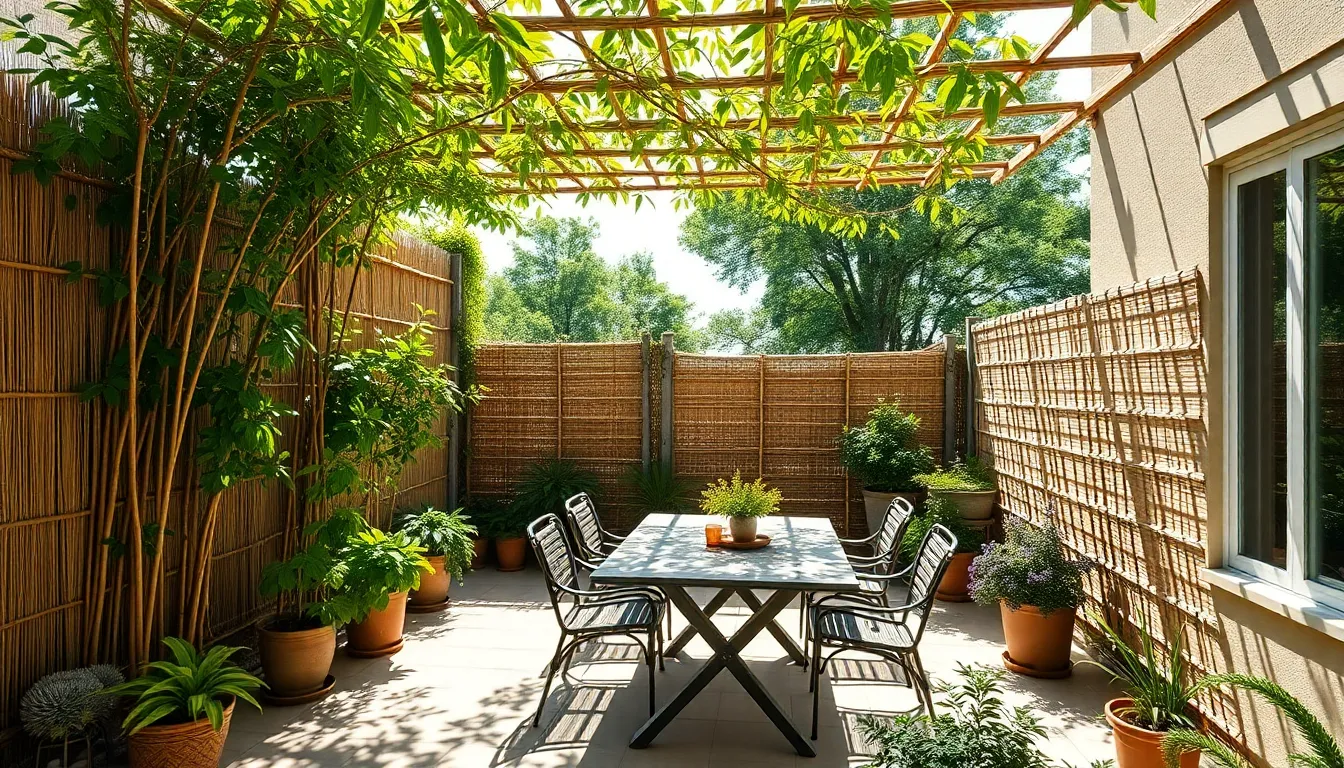
Natural bamboo screening and reed fencing deliver an eco-friendly shade solution that transforms your patio without very costly. These lightweight materials create tropical aesthetics while providing excellent airflow and privacy coverage.
Where to Find Discount Bamboo Materials
Local garden centers and nurseries offer the most affordable bamboo fencing rolls in our experience. Many carry seasonal inventory that goes on clearance during end-of-summer sales.
Home improvement stores like Home Depot and Lowe’s feature bamboo panels at competitive prices. We’ve found their best deals during spring garden promotions and fall clearance events.
Online marketplaces provide bulk purchasing opportunities that significantly reduce cost per square foot. Amazon and eBay sellers often offer wholesale pricing for larger quantities of bamboo screening.
Specialty eco-friendly retailers sometimes stock clearance bamboo fencing at deep discounts. These stores focus on sustainable outdoor materials and frequently rotate their inventory.
Community swap groups and reclaimed material sources present opportunities for very low-cost or free bamboo fencing. Local buy-nothing groups and construction salvage yards occasionally have bamboo materials available.
Installation Methods for Temporary Setups
Zip ties and bungee cords create secure attachments to existing porch railings and fence posts without causing surface damage. We recommend using UV-resistant ties that won’t degrade in sunlight.
Stakes and poles provide freestanding support for bamboo rolls in garden areas. Drive them 18 inches into the ground and secure fencing with cable ties or heavy-duty clips.
Garden staples and tent stakes work perfectly for short-term installations on grass surfaces. This method allows easy removal and repositioning as needed throughout the season.
Removable tension rods and eye hooks enable hanging bamboo panels like curtains from covered patios. Wall-mounted or ceiling-anchored systems allow quick installation and removal.
Outdoor fabric curtains and shade sails complement bamboo fencing beautifully when combined in layered installations. This approach creates enhanced shade coverage while maintaining design flexibility.
Repurposed Outdoor Furniture as Shade Structures
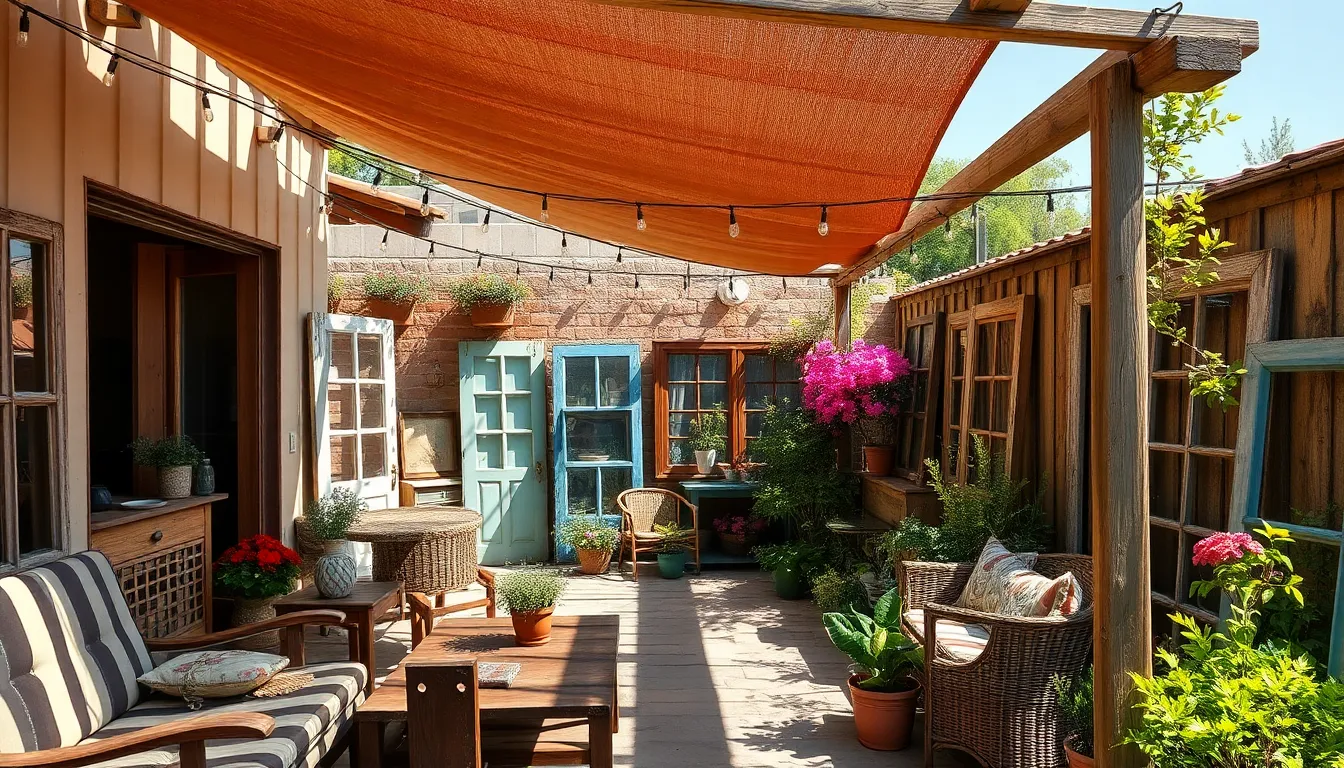
We can transform forgotten furniture pieces into creative shade answers that add character while keeping costs incredibly low. Old wooden pallets, discarded table frames, and worn-out chairs become the foundation for unique canopy structures that rival expensive store-bought options.
Old Doors and Windows as Shade Panels
Vertical shade panels from old doors create instant privacy screens that block harsh afternoon sun. We recommend mounting these weathered pieces on hinges to create adjustable barriers around your patio perimeter.
Window frames work exceptionally well as decorative shade elements when positioned strategically. Their solid construction provides partial coverage while maintaining airflow through the space. We’ve seen homeowners attach outdoor curtains or climbing plant supports to these frames for enhanced coverage.
Installation flexibility makes doors and windows particularly appealing for renters or those wanting temporary answers. Position them against existing structures or create standalone panels using weighted bases. Paint them in coordinating colors to match your patio’s aesthetic, or leave their weathered finish for rustic charm.
Cost savings become important when sourcing these materials from salvage yards, estate sales, or renovation projects. We typically find usable doors for $10-30 each, compared to $100+ for commercial shade panels of similar size.
Converting Broken Gazebos into Functional Shade
Frame restoration turns damaged gazebos into valuable shade structures without the expense of complete replacement. We start by assessing which structural elements need reinforcement with additional wood supports or metal bracing.
Fabric cover installation provides the finishing touch once the frame receives proper repairs. Stretch shade cloth or canvas covers over the rebuilt structure to create effective overhead protection. This approach costs roughly $50-150 in materials versus $300-800 for new gazebo purchases.
Repair techniques focus on strengthening connection points and replacing rotted sections with reclaimed lumber. We secure loose joints with galvanized bolts and treat exposed wood with weatherproofing stain to extend the structure’s lifespan.
Creative modifications allow us to adapt gazebo frames for exact patio layouts. Remove damaged sections to create partial coverage, or combine multiple broken frames into larger shade structures. Add string lighting or hanging planters to enhance the restored gazebo’s appeal while maintaining its primary shade function.
Seasonal Shade Solutions That Store Easily
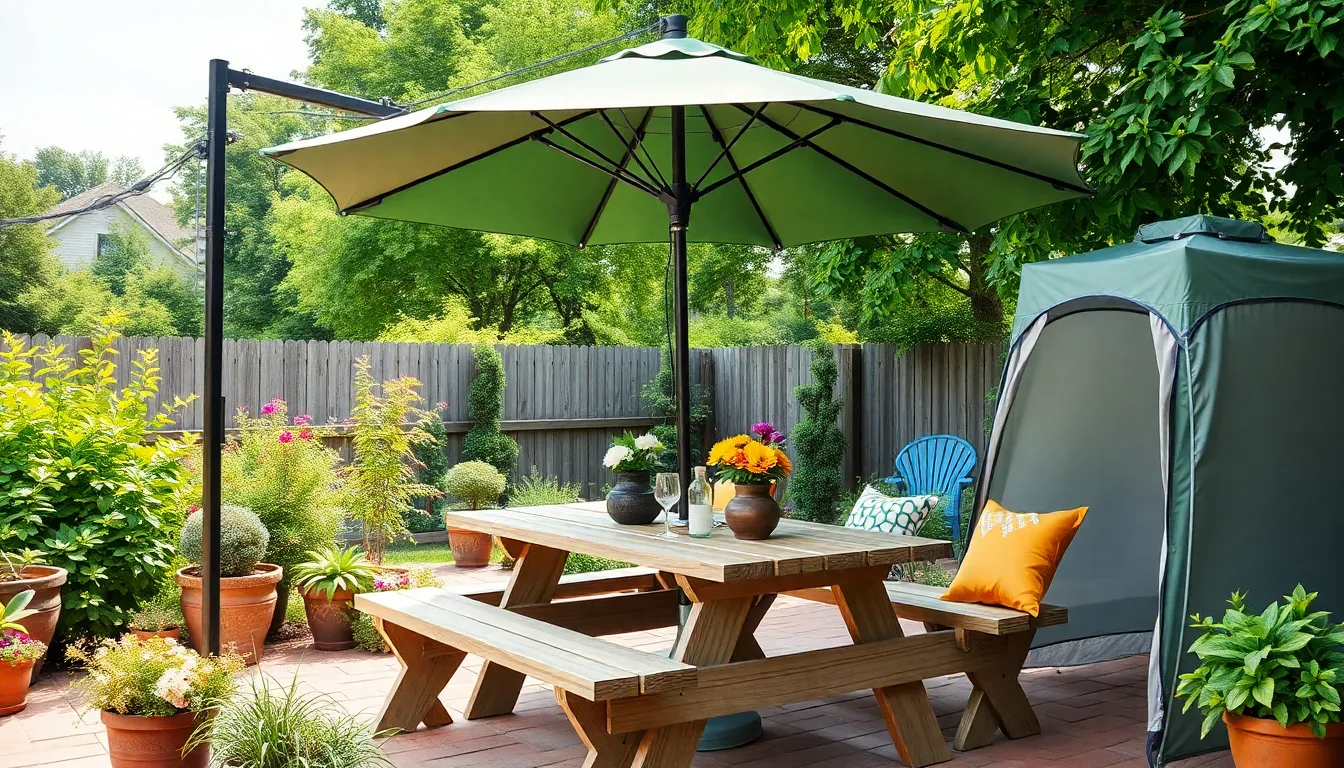
We’ve found that seasonal shade answers offer the perfect balance of functionality and convenience for outdoor spaces. These temporary options let us enjoy comfortable patios during hot months while providing easy storage when seasons change.
Collapsible Options for Renters
Freestanding patio umbrellas top our list for renter friendly shade answers. These versatile options start around $65 and come with wheeled bases that make repositioning effortless. We can move them throughout the day to follow shade patterns without any permanent installation.
Pop up canopies provide instant shelter from both sun and rain starting at approximately $239. These portable structures set up in minutes and collapse into compact packages for apartment storage. We recommend choosing models with carrying cases for easy transport between rental properties.
Outdoor curtains on tension rods create customizable shade zones without drilling holes or making property modifications. These fabric panels hang between existing structures like porch railings or fence posts. We can adjust their height and width to match changing sun angles throughout the day.
Shade sails with temporary anchor points offer modern styling while remaining completely removable. These marine grade fabric panels attach to portable stands or existing structures using removable hardware. We can tension them properly for wind resistance then store them flat during off seasons.
Multi-Purpose Items That Double as Shade
Outdoor curtains and pergola curtains serve triple duty as shade providers, privacy screens, and decorative elements. These fabric panels enhance our patio’s aesthetic appeal while blocking harsh sunlight. We can choose from weather resistant materials that withstand seasonal storage cycles.
Furniture with built in shade maximizes our budget by combining seating and sun protection in single units. Picnic tables with attached umbrellas and cabana style benches provide functional seating areas with integrated shade coverage. These pieces eliminate the need for separate shade structures.
Decorative privacy screens create intimate seating areas while blocking afternoon sun from exact angles. These freestanding panels often feature attractive designs that enhance our outdoor decor. We can position them strategically to create multiple shade zones throughout larger patio spaces.
Convertible gazebo frames adapt to changing weather conditions and seasonal needs. These structures accept various cover materials from mesh panels for bug protection to solid fabric for rain shelter. We can swap covers based on seasonal requirements while keeping the same basic frame structure.
Conclusion
Creating the perfect shaded patio doesn’t have to drain your wallet. We’ve shown you that with a little creativity and smart shopping you can transform any outdoor space into a cool comfortable retreat.
Whether you choose DIY shade sails bamboo screening or repurposed materials the key is starting with one solution and building from there. These budget-friendly options prove that effective shade coverage is within everyone’s reach.
Your patio should be a place where you can relax and enjoy the outdoors without battling harsh sun or very costly. With these affordable shade ideas you’re well-equipped to create an outdoor oasis that fits both your lifestyle and your budget.
Frequently Asked Questions
How much can DIY shade sails reduce outdoor temperatures?
DIY shade sails can reduce outdoor temperatures by up to 15 degrees Fahrenheit while costing 70% less than permanent shade structures. They’re made from budget-friendly materials like canvas drop cloths and outdoor fabric remnants, making them an affordable cooling solution for patios and outdoor spaces.
What materials do I need to build a DIY shade sail?
You’ll need canvas drop cloths or outdoor fabric remnants for the sail, stainless steel grommets for corner reinforcement, and marine-grade rope for durability. Additional hardware includes tension hooks and sturdy anchor points like fence posts or trees to secure the sail properly.
Can I use regular tarps for outdoor shade?
Yes, repurposed tarps and drop cloths work as instant shade solutions. Secure them using sturdy anchor points, tension hooks, and marine-grade bungee cords. Reinforce corners and angle properly to prevent water pooling. You can customize their appearance with outdoor fabric paint for better aesthetics.
Where can I find affordable patio umbrellas?
Check thrift stores, clearance sales, and end-of-season sales for significant discounts on patio umbrellas. Many older umbrellas can be refurbished with new fabric or hardware. Grouping multiple small umbrellas can cover larger areas more affordably than one large umbrella.
What’s the best wood for building a budget pergola?
Reclaimed wood is an eco-friendly and cost-effective option for pergola construction. Always inspect the wood quality for structural integrity and treat it with weatherproofing solutions. Salvage yards and construction sites often have suitable reclaimed lumber at reduced prices.
How do I create natural shade with plants?
Plant fast-growing vines like morning glories or clematis along temporary trellises for natural cooling canopies. These plants provide shade while improving air quality and creating privacy. Temporary trellises can be moved seasonally and require minimal investment compared to permanent structures.
Where can I buy discount bamboo screening materials?
Find affordable bamboo screening at local garden centers, home improvement store clearance sections, online marketplaces, and community swap groups. End-of-season sales often offer significant discounts on outdoor materials. Check for bulk pricing when covering larger areas.
How do I install bamboo fencing temporarily?
Use zip ties, bungee cords, and removable tension rods for temporary bamboo fencing installation. These methods allow for easy removal and repositioning without permanent modifications to your patio. Combine with outdoor curtains and shade sails for layered coverage.
Can I repurpose old furniture for shade structures?
Yes, old wooden pallets, discarded table frames, doors, and windows can be converted into unique shade panels. Salvage yards offer cost-effective materials for creating vertical shade structures that provide both privacy and airflow while maintaining budget-friendly construction costs.
What are the best seasonal shade solutions for small spaces?
Freestanding patio umbrellas, pop-up canopies, and outdoor curtains on tension rods work well for seasonal use. These solutions provide instant shelter, easy repositioning, and compact storage. Convertible gazebo frames adapt to different cover materials based on seasonal needs.

